
Lightning detector
Encyclopedia
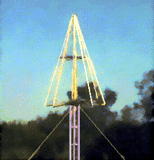
Thunderstorm
A thunderstorm, also known as an electrical storm, a lightning storm, thundershower or simply a storm is a form of weather characterized by the presence of lightning and its acoustic effect on the Earth's atmosphere known as thunder. The meteorologically assigned cloud type associated with the...
s. There are three primary types of detectors: ground-based systems using multiple antennas, mobile systems using a direction and a sense antenna in the same location (often aboard an aircraft), and space-based systems.
The device was invented in 1894 by Alexander Stepanovich Popov
Alexander Stepanovich Popov
Alexander Stepanovich Popov was a Russian physicist who was the first person to demonstrate the practical application of electromagnetic waves....
. It also was the first radio receiver
Receiver (radio)
A radio receiver converts signals from a radio antenna to a usable form. It uses electronic filters to separate a wanted radio frequency signal from all other signals, the electronic amplifier increases the level suitable for further processing, and finally recovers the desired information through...
in the world.
Ground-based and mobile detectors calculate the direction and severity of lightning
Lightning
Lightning is an atmospheric electrostatic discharge accompanied by thunder, which typically occurs during thunderstorms, and sometimes during volcanic eruptions or dust storms...
from the current location using radio direction-finding techniques together with an analysis of the characteristic frequencies emitted by lightning. Ground-based systems use triangulation
Triangulation
In trigonometry and geometry, triangulation is the process of determining the location of a point by measuring angles to it from known points at either end of a fixed baseline, rather than measuring distances to the point directly...
from multiple locations to determine distance, while mobile systems estimate distance using signal frequency and attenuation
Attenuation
In physics, attenuation is the gradual loss in intensity of any kind of flux through a medium. For instance, sunlight is attenuated by dark glasses, X-rays are attenuated by lead, and light and sound are attenuated by water.In electrical engineering and telecommunications, attenuation affects the...
. Space-based lightning detectors, on artificial satellites, can locate range, bearing and intensities by direct observation.
Ground-based lightning detector networks are used by meteorological services like the National Weather Service
National Weather Service
The National Weather Service , once known as the Weather Bureau, is one of the six scientific agencies that make up the National Oceanic and Atmospheric Administration of the United States government...
in United States
United States
The United States of America is a federal constitutional republic comprising fifty states and a federal district...
and the Meteorological Service of Canada
Meteorological Service of Canada
The Meteorological Service of Canada , also known as "The Canadian Weather Service", is a division of Environment Canada, which primarily provides public meteorological information and weather forecasts and warnings of severe weather and other environmental hazards...
, and by other organizations like electrical utilities and forest fire prevention services.
Limitations
Each system used for lightning detection has its own limitations. These include:- A ground-based lightning network must be able to detect a strike with at least three antennas to locate it with an acceptable margin of error. This often leads to the rejection of cloud-to-cloud lightning, as one antenna might detect the position of the strike on the starting cloud and the other antenna the receiving one. As a result, ground-based networks have a tendency to underestimate the number of strikes, especially at the beginning of storms where cloud-to-cloud lightning is prevalent.
- Since they use attenuation rather than triangulation, mobile detectors sometimes mistakenly indicate a weak lightning strike nearby as a strong one further away, or vice-versa.
- Space-based lightning networks suffer from neither of these limitations, but the information provided by them is often several minutes old by the time it is widely available, making it of limited use for real-time applications such as air navigation.
Lightning detectors vs. weather radar
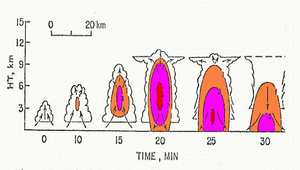
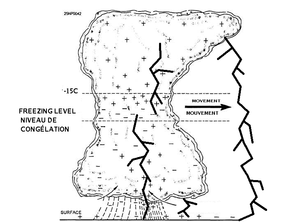
Weather radar
Weather radar, also called weather surveillance radar and Doppler weather radar, is a type of radar used to locate precipitation, calculate its motion, estimate its type . Modern weather radars are mostly pulse-Doppler radars, capable of detecting the motion of rain droplets in addition to the...
are used together to detect storms. Lightning detectors indicate electrical activity, while weather radar indicates precipitation. Both phenomena are associated with thunderstorms and can help indicate storm strength.
The first image on the right shows the life cycle of a thunderstorm:
- Air is moving upward due to instability.
- Condensation occurs and radar detects echoes above the ground (colored areas).
- Eventually the mass of rain drops is too large to be sustained by the updraft and they fall toward the ground.
The cloud must develop to a certain vertical extent before lightning is produced, so generally weather radar will indicate a developing storm before a lightning detector does. It is not always clear from early returns if a shower cloud will develop into a thunderstorm, and weather radar also sometimes suffers from a masking effect by attenuation, where precipitation close to the radar can hide (perhaps more intense) precipitation further away. Lightning detectors do not suffer from a masking effect and can provide confirmation when a shower cloud has evolved into a thunderstorm.
Lightning may be also located outside the precipitation recorded by radar. The second image shows that this happens when strikes originate in the anvil of the thundercloud (top part blown ahead of the cumulonimbus cloud
Cumulonimbus cloud
Cumulonimbus is a towering vertical cloud that is very tall, dense, and involved in thunderstorms and other inclement weather. Cumulonimbus originates from Latin: Cumulus "Heap" and nimbus "rain". It is a result of atmospheric instability. These clouds can form alone, in clusters, or along a cold...
by upper winds) or on the outside edge of the rain shaft. In both cases, there is still an area of radar echoes somewhere nearby.
Aviation use
Large airliners are more likely to use weather radar than lightning detectors, since weather radar can detect smaller storms that also cause turbulence; however, modern avionics systems often include lightning detection as well, for additional safety.For smaller aircraft, especially in general aviation
General aviation
General aviation is one of the two categories of civil aviation. It refers to all flights other than military and scheduled airline and regular cargo flights, both private and commercial. General aviation flights range from gliders and powered parachutes to large, non-scheduled cargo jet flights...
, there are two main brands of lightning detectors (often referred to as sferics, short for radio atmospherics): Stormscope, produced originally by Ryan (later B.F. Goodrich) and currently by L-3 Communications, and the Strikefinder, produced by Insight. Lightning detectors are inexpensive and lightweight, making them attractive to owners of light aircraft (particularly of single-engine aircraft, where the aircraft nose is not available for installation of a radome
Radome
A radome is a structural, weatherproof enclosure that protects a microwave or radar antenna. The radome is constructed of material that minimally attenuates the electromagnetic signal transmitted or received by the antenna. In other words, the radome is transparent to radar or radio waves...
).
Personal lightning detectors
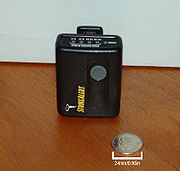
Pager
A pager is a simple personal telecommunications device for short messages. A one-way numeric pager can only receive a message consisting of a few digits, typically a phone number that the user is then requested to call...
, personal lightning detectors are popular among golfers, campers, law enforcement, sports officials and other persons who work or recreate outdoors. Personal lightning detectors function by detecting the electromagnetic pulse emitted by a lightning strike. By measuring the strength of the detected EMP
Electromagnetic pulse
An electromagnetic pulse is a burst of electromagnetic radiation. The abrupt pulse of electromagnetic radiation usually results from certain types of high energy explosions, especially a nuclear explosion, or from a suddenly fluctuating magnetic field...
, the device can then estimate how far away the detected strike was. When exposed to multiple detected strikes, some personal lightning detectors can even calculate and extrapolate the direction of the storm's movement relative to its position (approaching, departing or stationary).
Although personal lightning detectors do function well in regards to their ability to detect nearby lightning, they are quite basic in functionality when compared to professional lightning detectors. For example, they cannot tell where a lightning strike was located or from which direction the lightning is approaching, only that lightning is in the area. Also, since a personal lightning detector is triggered by EMPs, interference from other EMP-emitting devices (such as electronic equipment, appliances, fluorescent lights and even car engines) can sometimes result in either false alarms or missed strikes. This interference often has the additional effect of preventing personal lightning detectors from functioning properly while indoors. Despite these limitations, personal lightning detectors continue to increase in popularity among individuals and professionals.
Professional-quality portable lightning detectors
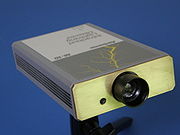
Sensitivity (electronics)
The sensitivity of an electronic device, such as a communications system receiver, or detection device, such as a PIN diode, is the minimum magnitude of input signal required to produce a specified output signal having a specified signal-to-noise ratio, or other specified criteria.Sensitivity is...
, particularly for intracloud (IC) lightning. Professional-quality portable lightning detectors improve performance in these areas by several techniques which facilitate each other, thus magnifying their effects:
- False signal elimination
A lightning discharge generates both a radio frequency (RF) electromagnetic signal – commonly experienced as “static” on an AM radio – and very short duration light pulses, comprising the visible “flash”. A lightning detector that works by sensing just one of these signals may misinterpret signals coming from sources other than lightning, giving a false alarm. Specifically, RF-based detectors may misinterpret RF noise, also known as RF Interference or RFI. Such signals are generated by many common environmental sources, such as auto ignitions, fluorescent lights, TV sets, light switches, electric motors, and high voltage wires. Likewise, light-flash-based detectors may misinterpret flickering light generated in the environment, such as reflections from windows, sunlight through tree leaves, passing cars, TV sets, and fluorescent lights.
However, since RF signals and light pulses rarely occur simultaneously except when produced by lightning, RF sensors and light pulse sensors can usefully be connected in a “coincidence circuit
Coincidence circuit
In physics, a coincidence circuit is an electronic device with one output and two inputs. The output is activated only when signals are received within a time window accepted as at the same time and in parallel at both inputs...
” which requires both kinds of signals simultaneously in order to produce an output. If such a system is pointed toward a cloud and lightning occurs in that cloud, both signals will be received; the coincidence circuit will produce an output; and the user can be sure the cause was lightning.
When a lightning discharge occurs within a cloud at night, the entire cloud appears to illuminate. In daylight these intracloud flashes are rarely visible to the human eye; nevertheless, optical sensors can detect them. Looking through the window of the space shuttle in early missions, astronauts used optical sensors to detect lightning in bright sunlit clouds far below. This application led to development of the dual signal portable lightning detector which utilizes light flashes as well as the “sferics” signals detected by previous devices.
- Improved Sensitivity
In the past, lightning detectors, both inexpensive portable ones for use on the ground and expensive aircraft systems, detected low frequency radiation because at low frequencies the signals generated by cloud-to-ground (CG) lightning are stronger (have higher amplitude) and thus are easier to detect. However, RF noise is also stronger at low frequencies. To minimize RF noise reception, low-frequency sensors are operated at low sensitivity (signal reception threshold) and thus do not detect less intense lightning signals. This reduces the ability to detect lightning at longer distances since signal intensity decreases with the square of distance. It also reduces detection of intracloud (IC) flashes which generally are weaker than CG flashes.
- Enhanced Intracloud Lightning Detection
The addition of an optical sensor and coincidence circuit not only eliminates false alarms caused by RF noise; it also allows the RF sensor to be operated at higher sensitivity and to sense higher frequencies characteristic of IC lightning and enable the weaker high frequency components of IC signals and more distant flashes to be detected.
The improvements described above significantly extend the detector’s utility in many areas:
- Early warning: Detection of IC flashes is important because they typically occur from 5 to 30 minutes before CG flashes and so can provide earlier warning of developing thunderstorms, greatly enhancing the effectiveness of the detector in personal-safety and storm-spotting applications compared to a CG-only detector. Increased sensitivity also provides warning of already-developed storms which are more distant but may be moving toward the user.
- Storm location: Even in daylight, “storm chasers” can use directional optical detectors that can be pointed at an individual cloud to distinguish thunderclouds at a distance. This is particularly important for identifying the strongest thunderstorms which produce tornadoes, since such storms produce higher flash rates with more high frequency radiation than weaker non-tornadic storms.
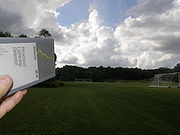
- Microburst prediction: IC flash detection also provides a method for predicting microbursts. The updraft in convective cells starts to become electrified when it reaches altitudes sufficiently cold so that mixed phase hydrometeors (water and ice particles) can exist in the same volume. Electrification occurs due to collisions between ice particles and water drops or water coated ice particles. The lighter ice particles (snow) are charged positively and carried to the upper portion of the cloud leaving behind the negatively charged water drops in the central part of the cloud. These two charge centers create an electric field leading to lightning formation. The updraft continues until all the liquid water is converted to ice, which releases latent heat driving the updraft. When all the water is converted, the updraft collapses rapidly as does the lightning rate. Thus the increase in lightning rate to a large value, mostly due to IC discharges, followed by a rapid dropoff in rate provides a characteristic signal of the collapse of the updraft which carries particles downward in a downburst. When the ice particles reach warmer temperatures near cloudbase they melt causing atmospheric cooling; likewise, the water drops evaporate, also causing cooling. This cooling increases air density which is the driving force for microbursts. The cool air in “gust fronts” often experienced near thunderstorms is caused by this mechanism.
- Storm identification/tracking: Some thunderstorms, identified by IC detection and observation, make no CG flashes at all and would not be detected with a CG sensing system. IC flashes also are many times as frequent as CG so provide a more robust signal. The relative high density (number per unit area) of IC flashes allows convective cells to be identified when mapping lightning whereas CG lightning are too few and far between to identify cells which typically are about 5 km in diameter. In the late stages of a storm the CG flash activity subsides and the storm may appear to have ended—but generally there still is IC activity going on in the residue mid-altitude and higher cirrus anvil clouds, so the potential for CG lightning still exists.
- Storm intensity quantification: Another advantage of IC detection is that the flash rate (number per minute) is proportional to the 5th power of the convective velocity of the updrafts in the thundercloud. This non-linear response means that a small change in cloud height, hardly observable on radar, would be accompanied by a large change in flash rate. For example, a hardly noticeable 10% increase in cloud height (a measure of storm severity) would have a 60% change in total flash rate, which is easily observed. “Total lightning” is both the generally invisible (in daylight) IC flashes that stay within the cloud as well as the generally visible CG flashes that can be seen extending from cloud base to ground. Because most of the total lightning is from IC flashes, this ability to quantify storm intensity occurs mostly through detection of IC discharges. Lightning detectors that sense only low frequency energy detect only IC flashes that are nearby, so they are relatively inefficient for predicting microbursts and quantifying convective intensity.
- Tornado Prediction: Severe storms that produce tornadoes are known to have very high lightning rates and most lightning from the deepest convective clouds is IC , therefore the ability to detect IC lightning provides a method for identifying clouds with high tornado potential.
Patents
Some of the intellectual property associated with sophisticated lightning detectors has been patented. Patent documents are a valuable source of further information about the technical issues discussed above; still more information can be found in other documents cited by the patents. A sampling of patents representative of the history of improvements to the art of single-sensor lightning detection are listed below, in the order issued.| 4023408 | May 1977 | “Stormscope” |
| 4198599 | Apr 1980 | “Gated Lightning Detection System” |
| 4801942 | Jan 1989 | “Interferometric lightning ranging system” |
| 5057820 | Oct 1991 | “Optical Warning System” |
| 5245274 | Sep 1993 | “Storm Monitor” |
| 5396220 | Mar 1995 | “Storm Warning System” |
| 6246367 | Jun 2001 | “Lightning locating system” |
Lightning range estimation
When an RF lightning signal is detected at a single location it is possible to determine its direction using a crossed-loop magnetic direction finder, but it is difficult to determine its distance. Attempts have been made using the amplitude of the signal, but this does not work very well because lightning signals have considerable variation in intensity. Thus, using amplitude for distance estimation, a strong flash appears to be nearby and a weaker signal from the same flash – or from a weaker flash from the same storm cell – appears to be farther away.To understand this aspect of lightning detection it is necessary to know that a lightning “flash” generally consists of several strokes, a typical number of strokes from a CG flash is in the range 3 to 6 but some flashes can have more than 10 strokes.
The initial stroke leaves an ionized path from the cloud to ground and subsequent “return strokes”, separated by an interval of about 50 milliseconds, go up that channel. The complete discharge sequence is typically about ½ second in duration while the duration of the individual strokes varies greatly between 100 nanoseconds and a few tens of microseconds. The strokes in a CG flash can be seen at night as a non-periodic sequence of illuminations of the lightning channel. This can also be heard on sophisticated lightning detectors as individual staccato sounds for each stroke, forming a distinctive pattern.
Single sensor lightning detectors have been used on aircraft and while the lightning direction can be determined from a crossed loop sensor, the distance can not be determined reliably because the signal amplitude varies between the individual strokes described above,
and these systems use amplitude to estimate distance. Because the strokes have different amplitudes, these detectors provide a line of dots on the display like spokes on a wheel extending out radially from the hub in the general direction of the lightning source. The dots are at different distances along the line because the strokes have different intensities. These characteristic lines of dots in such sensor displays are called “radial spread”.
These sensors operate in the very low frequency (VLF) and low frequency (LF) range (below 300 kHz) which provides the strongest lightning signals: those generated by return strokes from the ground. But unless the sensor is close to the flash they do not pick up the weaker signals from IC discharges which have a significant amount of energy in the high frequency (HF) range (up to 30 MHz).
Another issue with VLF lightning receivers is that they pick up reflections from the ionosphere so sometimes can not tell the difference in distance between lightning 100 km away and several hundred km away. At distances of several hundred km the reflected signal (termed the “sky wave”) is stronger than the direct signal (termed the “ground wave”).
Because of the difficulty in obtaining distance to lightning with a single sensor, the only current reliable method for positioning lightning is through interconnected networks of spaced sensors covering an area of the Earth’s surface using time-of-arrival differences between the sensors and/or crossed-bearings from different sensors. Several such national networks currently operating in the U.S. can provide the position of CG flashes but currently cannot reliably detect and position IC flashes.
There are a few small area networks (like Kennedy Space Center's LDAR network, one of whose sensors is pictured at the top of this article) that have VHF time of arrival systems and can detect and position IC flashes. These are called lightning mapper arrays. They typically cover a circle of 30–40 miles diameter.
See also
- Automated airport weather stationAutomated airport weather stationAutomated airport weather stations are automated sensor suites which are designed to serve aviation and meteorological observing needs for safe and efficient aviation operations and weather forecasting...
- Lightning prediction systemLightning prediction systemA lightning prediction system detects atmospheric conditions likely to produce lightning strikes in a certain area and sounds an auditory alert, warning those nearby that lightning is imminent and giving them the chance to find safety before the storm actually impacts the area...
- Convective storm detectionConvective storm detectionConvective storm detection is the meteorological observation of deep, moist convection and consists of detection, monitoring, and short-term prediction. This term includes the minority of storms which do not produce lightning and thunder. Convective storms can produce tornadoes as well as large...
External links
- Recent North American lightning activity from StrikestarUS
- Recent North American lightning activity from Environment CanadaEnvironment CanadaEnvironment Canada , legally incorporated as the Department of the Environment under the Department of the Environment Act Environment Canada (EC) (French: Environnement Canada), legally incorporated as the Department of the Environment under the Department of the Environment Act Environment...
- Lightning detection guide (PDF) from the U.S. NOAANational Oceanic and Atmospheric AdministrationThe National Oceanic and Atmospheric Administration , pronounced , like "noah", is a scientific agency within the United States Department of Commerce focused on the conditions of the oceans and the atmosphere...
- http://thunder.msfc.nasa.gov/primer/index.htmlLightning origin and research on detection from space from NASANASAThe National Aeronautics and Space Administration is the agency of the United States government that is responsible for the nation's civilian space program and for aeronautics and aerospace research...
] - Blog posting about lightning detection and air traffic controlAir traffic controlAir traffic control is a service provided by ground-based controllers who direct aircraft on the ground and in the air. The primary purpose of ATC systems worldwide is to separate aircraft to prevent collisions, to organize and expedite the flow of traffic, and to provide information and other...
- Archived e-mail thread comparing the Stormscope and Strikefinder
- Live South Of England lightning activity from The Isle of Wight Weather Station
- Australian national storm tracker from Weatherzone Australia
- Lightning Radar Weather amateur lightning detection network
- WX-500 Stormscope Series II Weather Mapping Sensor User’s Guide (PDF)
- M-10 Intracloud Lightning Detector Operating Manual from Airborne Research Associates
- Clearwater Beach Florida Lightning Network from Neuvision
- WWLLN World Wide Lightning Location Network

